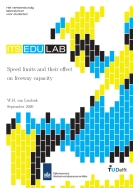In this thesis an investigation is performed into the effects of different speed limits on capacity. Much is known about factors that change the capacity of a roadway, but only very limited knowledge is available about the actual effects of a speed limit change on the capacity distribution. Several locations have been selected to be studied in this paper and two samples of locations have been generated. The first sample consists of a total of eight locations which have experienced a speed limit change from 120 to 130 km/h. The second sample consists of a total of seventeen locations, for which eleven locations have experienced a speed limit change from 120 to 130 km/h and subsequently to 100 km/h and for which the remaining six locations have experienced a speed limit change from 120 to 100 km/h. In these samples only two-lane bottlenecks are included, because these types of bottlenecks are most sensitive to congestion and because there is a clear distinction between the passing lane (left) and the shoulder lane (right) which provides a simple framework for the analysis of lane choice behavior.
For the comparison of capacity distributions of the “eight-location” sample it was found that, for the complete roadway, 4 out of 8 locations showed a significant increase in capacity, while 3 out of the remaining 4 locations showed a significant decrease in capacity and 1 location was indeterminate. For the passing lane, it was found that breakdown flows had significantly increased for 5 out of 8 locations and had significantly decreased for 2 out of 8 locations, indicating increased passing lane use. For the shoulder lane, it was found that breakdown flows had significantly increased at 4 out of 8 locations and significantly decreased at the remaining 4. On the whole, despite recording significant changes for all locations but one, no uniform trend was visible in the data for the effect of the speed limit on capacity. It was, however, clear that the fraction of flow in the passing lane had increased under the 130 km/h limit.
Despite several efforts at isolating the effects of a speed limit change on the capacity, it has proven to be difficult to account for all the other affect that affect capacity. As such, it is uncertain whether significant changes to the capacity distribution have occurred as a consequence of the change in the speed limit. On the basis of lane flow distribution data, it is relatively certain that a relation exists between the height of the speed limit and the utilization rate of the passing lane, which does indirectly affect the capacity of the roadway. Moreover, at least for the 120 km/h limit, clear and consistent evidence has been found that breakdown flows under this limit are higher than under the 130 km/h. As such, it can be expected that it may very well be the case that the speed limit does significantly affect capacity and that speed limits above 120 km/h lead to sub-optimal values of capacity.
